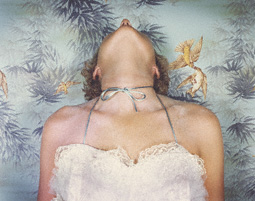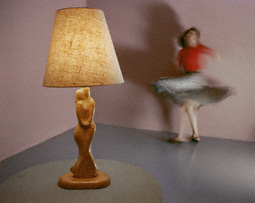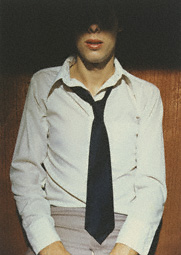|
Since she emerged in the late 1970s as one of the first important practitioners of the "fabricated photographs" movement, Jo Ann Callis (American, born 1940) has made adventurous contributions in the areas of color photography, sculpture, painting, and digital imagery. For her, photography is another studio tool to be used, along with the sets she creates and the models she directs, to render the sensual tones and textures of fabric and food, or to animate clay figures of her own making. The persistent inventiveness of Callis's work has made her a force in Southern California art and in recent photographic practice.
Callis began her art studies in Ohio in the 1950s. After marriage and child rearing, she returned to photography in the 1970s to finish her undergraduate degree, and continued on to a graduate degree in the arts at UCLA. Her avant-garde style of fabricating photographs was soon publicly recognized, and her work was exhibited and published internationally. At the same time, she developed her own role as teacher at the California Institute of the Arts (CalArts).
|
 |
|
Throughout her career, Callis has created complex sets for her photographs. She often makes her own props, hires and directs models, and designs the lighting.
In this image, a piece of furniture—a modest lamp portraying an entwined couple in its carved wooden base—is made an equal character in this staged drama. Its foreground placement and the close proximity of the camera enhance its scale and solid presence, while the female figure at right, in patterned skirt and red blouse, spins in a frenzied motion. Although set in an unusually sparse interior, the warm lamplight and neutral decor suggest this is a domestic scene, but the coupling of the lamp base also implies romance, possibly the reason for the model's turmoil.
|
 |
 |
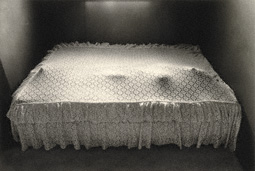
 |
 |
Figure under Bedspread, 1974
|
 |
Interior feelings and interior spaces have been the theme of Callis's work from the beginning. She keeps the plot simple, often relying on important memories or current emotions, and she has mastered the ability to construct situations that are as scary as they are beautiful, as tense as they are comfortable. For Callis, the familiar is often full of anxiety as well as pleasure.
This early black and white image exemplifies her ability to create an unsettling image from an otherwise benign subject.
|
 |
|
The production of boxed, limited-edition portfolios of photographs by artists, art schools, and commercial galleries built substantial momentum in the 1980s. In 1984 eight of Callis's color images, including Man and Tie, were selected for a monographic portfolio published by Sequoia Dye Transfer Printing in the costly, labor-intensive, but beautifully saturated and more permanent process of dye transfer.
From seeing the not-quite-natural color of Paul Outerbridge's carbro prints in 1976, Callis was inspired to use color for her own emotionally expressive pictures. It was the fabricated, fetishistic vein running through Outerbridge's commercial and personal images that convinced Callis that she was on the right path.
See the related exhibition, Paul Outerbridge: Command Performance.
|
 |
 |
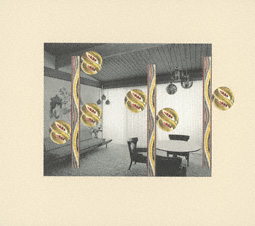
 |
 |
Untitled (Poles and Spheres), from the Decor series, 2005
|
 |
Rooms and the furniture that fills them, that makes them comfortable, have been a recurring motif for Callis. In the 1990s she made her own small beds from clay, fired and flocked them, then photographed them in tiny rooms and finally matted them in fabrics to match the miniature setting. The focus on furniture took her into painting, also on a small scale, with chairs, sofas, and love seats borrowed from the online reproductions of a Herman Miller catalogue published in the 1950s.
For her recent work, Callis produces digital layering using appropriated 1960s real estate photography held by the Los Angeles Public Library. She subtracts here and there, imposes another layer of fanciful interior designs, creates a broad frame, and adds color to these suburban interiors: the wall-to-wall carpets, sliding glass doors, patios, double beds, bedroom mirrors, and pleated window treatments that she recalls from her first years in Southern California.
|
 |
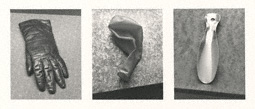
 |
 |
Glove, Balloon, Shoehorn, 1983
|
 |
 |
Callis refers to the group of combined black-and-white still life studies she made in 1982–83 as The Grid series. She started with familiar household objects that, individually, gave her comfort. She selected the adjacencies with care and added strong, focused overhead lighting, intending to create a sort of drama, or imagined conversation, between the objects. The resulting assemblages cause the viewer to give common objects new importance and, perhaps, new meaning.
All images © Jo Ann Callis
|
 |
